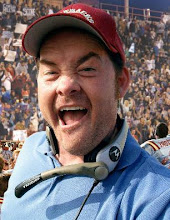Post by Coach Huey on Dec 29, 2005 0:34:28 GMT -6
Penalties In Football--Good or Bad?
- Jim Reese -
In order to better understand the role penalties play in football games and their effect on winning and losing, I recently surveyed hundreds of games at various levels. The results were both enlightening and conclusive.
A study of nearly 400 high school, college and professional football games was undertaken during the 2003 season. The information was obtained from ESPN.com, NFL.com, and an area daily newspaper.
The results showed that high school teams having more penalty yards in a game won two-thirds of those games (67%), while college teams with more penalties won approximately half the time (52%). But NFL teams won only 45% of the games in which they were assessed more penalty yards than their opponents. (A similar number of games at each of the three levels was sampled.)
The results concluded that in high school the more you were penalized, the greater your chances were of winning. In college, it was about even, while in the NFL, it was a factor that led to teams losing more often than they won.
In high school, the percentage of the more penalized team winning was much greater (67%-52%) than in college. At the college level, in order to win, the need to be more disciplined is much greater as the quality of opponents evens out and, it can be assumed, more attention is paid by coaches to treating penalties as mistakes.
Furthermore, in the NFL, (45%), where excessive penalties can lead to a player losing his job, it is clear that coaches keep it pretty much under control and place penalties in their proper perspective, i.e., mistakes to be avoided.
But in high school, teams that win consistently are also the most highly penalized.
It is interesting to speculate on the cause of this relationship between excessive penalties and how they relate to winning high school football games.
Very often when confronted with these statistics, high school coaches have said, “well, that can’t be. We have always taught our players that in order to win, we must avoid penalties. Those numbers can’t be right.”
One veteran coach even said, “I can never remember us winning a game and having more penalties than our opponent.” After being told that his team had more penalty yards than his opponents in four of his five victories, he was even more incredulous.
Some high school coaches said, “well, they are probably offside and motion penalties.” But when shown that their team’s average penalty was closer to ten yards than five, they soon realized their thinking was flawed. “Well, the kids are just being aggressive,” was another often heard response from high school coaches, almost as a justification, once they were resigned to the statistics.
Some further interesting statistics from the study:
In high school, when a team committed more penalties than its opponent and won, it did so with a point difference 53% greater than when the team with fewer penalty yards won.
Of the 26 teams studied in the high school section of the survey, the top 13 penalized teams had a combined record of 82-48. The 13 least penalized teams were 40-75.
High school teams in the survey exceeded 100 yards in penalties in a single game 30 times, 24 of which were by teams in the more penalized group.
The top five penalized high school teams studied averaged 10 penalties a game versus 4.9 for the lowest five.
Anomalies: Two of the lowest five penalized teams combined for a 15-4 record, showing that you don’t have to lead in penalties to win. And conversely, and shamefully, the single most often penalized team went 3-7.
Of the 130 high school games studied, more than one in five was a shutout, the average score being 35-0, with the more penalized team winning 83% of those games.
The top 12 college teams in 2003 averaged 58 penalty yards per game compared to 84 yards (adjusted) per game for the top 12 high school teams studied. That represents a difference of 45% more penalties in high school than in college for the top teams.
One then must question why high school teams that have a high winning percentage so often have a much higher number of penalties called on them.
There would be general agreement, I am sure, that high school players can be much more easily intimidated than college or professional players. The team scoring first in a high school game wins at a rate of 75%. When a team makes the first two scores in a high school game, it goes on to win 92% of the time. If a team is ahead at the half in a high school football game, the odds are better than 9-1 in its favor that it will win the game. In the first half of the 2003 high school season, teams with more penalties won 58% of the time; in the second half of the season, that number rose to 80%.
So if a team in high school tends to give up early, as many do who fall behind and don’t think they “should” win, it becomes very easy for a superior team to bully an underdog and begin to pile up penalties as they go on to win, usually by a larger score than normal. (Note the 53% difference in scores when the more penalized team wins, as mentioned above.)
Is it because some coaches know the above and train their players accordingly, e.g., “don’t stop on the echo of the whistle but rather stop on the echo of the echo?” Might they preach, “don’t be concerned with making a penalty. Just keep on being aggressive.” Or, is it true, as many coaches state, that they really don’t know the true penalty picture? In any event, it is an indictment of the coaching fraternity for either ignorance or apathy. Or both.
From observations at games, a very high percentage of the teams in the most penalized group are well drilled and seldom go offside or illegally in motion, both five-yard penalties. When you average closer to ten yards than five for each penalty, it can be nothing less than predominantly major penalties that are being called.
No one should find fault with the referees, either. They are simply calling it as they see it.
There are, of course, ways for teams to deal with such run-a-way victories. A coach who is behind can request a running clock but some are reluctant to do so for fear they’ll be perceived as wimps or losers.
I suggest the answer rests with school principals and athletic directors. When it can be documented that a team is consistently in the top half in penalties and when it can be shown that those penalties are primarily of the 15 yard major variety such as unnecessary roughness, face mask, and unsportsmanlike conduct, I think a coach should be summoned to answer as to why that is taking place and how he will remedy the problem, and if he can’t, the school administrators should act and get the rules committees involved.
I think I know how the NFL would react if it found itself in a situation where two-thirds of its games were being won by the team with a greater amount of penalties. Fearful that it would result in a public perception that thugs had taken over the game, they would quickly change the rules.
Their solution might very well be a “penalty accelerator” wherein any team reaching a certain amount of penalty yards in a game, say 60 or 70, would see all further penalties above that total cause double yardage to be assessed. Perhaps high schools should consider such a policy now to rectify their existing problem.
The purpose of athletics is to train students for the future while they are enjoying the present. It is a way to teach fair play and observance of rules as a means to learn how society should conduct itself. A way must be found to level the playing field so that those two principles can move forward to the enjoyment of all, not just a chosen few.
There is something inherently wrong with a system that rewards breaking the rules.
Jim Reese was a quarterback and assistant coach at the University of Minnesota. He is now retired and lives in Tampa, Florida, where he reports on sports for a local newspaper.








